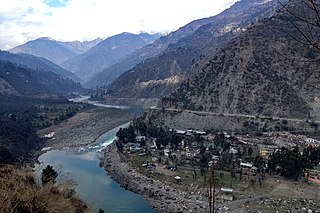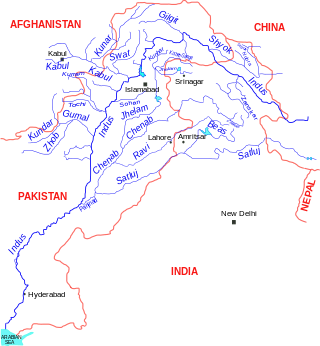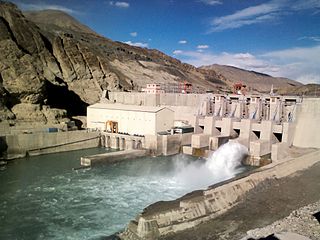
The Ravi River is a transboundary river crossing northwestern India and eastern Pakistan. It is one of five rivers associated with the Punjab region.

The Jhelum River is a river in the northern Indian subcontinent. It originates at Verinag and flows through the Indian-administered territory of Jammu and Kashmir, into Pakistan-administered Azad Kashmir, then the Pakistani province of Punjab. It is the westernmost of the five rivers of the Punjab region, and flows through the Kashmir Valley. It is a tributary of the Chenab River and has a total length of about 725 kilometres (450 mi).

The Chenab River is a major river that flows in India and Pakistan, and is one of the 5 major rivers of the Punjab region. It is formed by the union of two headwaters, Chandra and Bhaga, which rise in the upper Himalayas in the Lahaul region of Himachal Pradesh, India. The Chenab flows through the Jammu region of Jammu and Kashmir, India, into the plains of Punjab, Pakistan, before ultimately flowing into the Indus River. The Battle of Chenab was fought between Sikhs and Afghans on the bank of the river.

Wular Lake, also known as Wolar in Kashmiri, is one of the largest fresh water lakes in South Asia. It is located near Bandipora town in the Bandipora district of Jammu and Kashmir, India. The lake basin was formed as a result of tectonic activity and is fed by the Jhelum River and stream Madhumati and Arin.

The Indus Water Treaty (IWT) is a water-distribution treaty between India and Pakistan, arranged and negotiated by the World Bank, to use the water available in the Indus River and its tributaries. It was signed in Karachi on 19 September 1960 by then Indian Prime Minister Jawaharlal Nehru and then Pakistani president Field Marshal Ayub Khan.

The Neelum River, or Kishanganga River, is a river in the Kashmir region in the Indian subcontinent. It originates in Ganderbal district of Indian-administered Kashmir, flows through the Neelam Valley into Pakistani-administered Kashmir, where parts of its course fall along the Line of Control, before merging with the Jhelum River near the city of Muzaffarabad.

Baglihar Dam, also known as Baglihar Hydroelectric Power Project, is a run-of-the-river power project on the Chenab River in the Ramban district of Jammu and Kashmir, India. The first power project executed by the Jammu and Kashmir Power Development Corporation, it was conceived in 1992 and approved in 1996, with construction begun in 1999. The project was estimated to cost US$1 billion. The project consists of two-stage of 450MW each. The first stage of the project was completed in 2008-09 and was dedicated to the nation by the Prime Minister Manmohan Singh of India. The second stage of the project was completed in 2015–16, and was subsequently dedicated to the nation by the Prime Minister Narendra Modi.

Salal Dam, also known as Salal Hydroelectric Power Station, is a run-of-the-river hydropower project on the Chenab River in the Reasi district of the Jammu and Kashmir. It was the first hydropower project built by India in Jammu and Kashmir under the Indus Water Treaty regime. After having reached a bilateral agreement with Pakistan in 1978, with significant concessions made to Pakistan in the design of the dam, reducing its height, eliminating operating pool, and plugging the under-sluices meant for sediment management, India completed the project in 1987. The concessions made in the interest of bilateralism damaged the long-term sustainability of the dam, which silted up in five years. It currently runs at 57% capacity factor. Its long-term future is uncertain.

NHPC Limited is an Indian public sector hydropower company that was incorporated in 1975 to plan, promote and organise an integrated and efficient development of hydroelectric power. Recently it has expanded to include other sources of energy like solar, geothermal, tidal, and wind.
Dul Hasti is a 390 MW hydroelectric power plant in Kishtwar district of Jammu and Kashmir, India built by NHPC. The power plant is a run-of-the-river type on the Chenab River, in a rugged, mountainous section of the Himalayas, and several hundred kilometers from larger cities in the Jammu Division. It consists of a 70 m (230 ft) tall gravity dam which diverts water through a 9.5 km (5.9 mi) long headrace tunnel to the power station which discharges back into the Chenab. The project provides peaking power to the Northern Grid with beneficiary states being Jammu and Kashmir, Punjab, Haryana, Uttar Pradesh, Uttarakhand, Rajasthan, Delhi and Union Territory of Chandigarh. It was constructed between 1985 and 2007.
The Permanent Indus Commission (PIC) is a bilateral body comprising representatives from both India and Pakistan, established to oversee and ensure the implementation and management of the provisions set forth in the Indus Waters Treaty (IWT). Its primary role is to facilitate cooperation and address issues concerning the use and allocation of the Indus River system between the two countries.
Uri Dam is a 480 MW hydroelectric power station on the Jhelum River near Uri in Baramula district of the Jammu and Kashmir, India. It is located very near to the Line of Control, the de facto border between India and Pakistan. The station is largely built under a hill with a 10 km tunnel. It is of the run-of-the-river type without a large dam, since the Indus Waters Treaty gives Pakistan the exclusive right to regulate the Jhelum River. On 4 July 2014 a 240 MW Uri-II power project which is a new project located just downstream of Uri I, was inaugurated.

The Nimoo Bazgo Power Project is a run-of-the-river power project on the Indus River situated at Alchi village, 75 kilometres (47 mi) from Leh in the Indian Union Territory of Ladakh. The project was conceived on 1 July 2001 and approved on 8 June 2005, and construction began on 23rd Sept, 2006. The project involved construction of a 57-high m (187 ft) concrete dam with five spillway blocks of 13 m (43 ft) each having ogee profile. The dam is 247.9m in length. It was officially completed and open in August 2014.

The Chutak Hydroelectric Plant is a run-of-the-river power project on the Suru River in Kargil district in the Indian union territory of Ladakh. The barrage of the project is at Sarze village and the powerhouse is located on the right bank of the Suru near Chutak village. The project construction began on 23 September 2006, and the first three generators were commissioned in November 2012. The fourth was commissioned in January 2013.
The Kishanganga Hydroelectric Project is a run-of-the-river hydroelectric scheme in Jammu and Kashmir, India. Its dam diverts water from the Kishanganga River to a power plant in the Jhelum River basin. It is located near Dharmahama Village, 5 km (3 mi) north of Bandipore in the Kashmir valley and has an installed capacity of 330 MW.

Chenab Valley is a loosely-defined controversial term sometimes used to refer to parts of the Jammu Division of Jammu and Kashmir, India. It is used to refer to the present-day districts of Doda, Kishtwar, Ramban. These three districts used to be part of a single former district called Doda, which was created in 1948 out of the eastern parts of Udhampur district of the princely state of Jammu and Kashmir, and are sometimes collectively referred to as the Doda belt. The term is seen to be aimed at a communal break-up of the Jammu Division and iteration of Kashmiri Muslim irredentism.
The Pakal Dul Dam is an under construction concrete-face rock-fill dam on the Marusudar river, a tributary of the Chenab River, in Kishtwar district of the Indian Jammu and Kashmir. The primary purpose of the dam is hydroelectric power generation. It will divert water to the south through a 10 km (6.2 mi) long headrace tunnel and into power station on the reservoir of the Dul Hasti Dam, on the Chenab. In February 2014, the project was awarded to a consortium of domestic and foreign countries. It includes AFCONS, JP Prakash Associate Bharat Heavy Electricals. Pakistan, which relies on the Chenab downstream, views the dam as a violation of the Indus Water Treaty, whereas India states it is as per treaty provisions. Indian Commentator Harshil Mehta wrote that the project holds strategic interest for India, apart from utilising just Hydropower, along with Kiru and Ratle, and Ujh multipurpose project.
The Shahpurkandi Dam project is located on the Ravi River in Pathankot district, Punjab, India, downstream from the existing Ranjit Sagar Dam. The power houses will be constructed on Hydel Channel, which is downstream from Shahpurkandi Dam. The water released by Ranjit Sagar Dam is to be utilised for generating power for this project. The project will generate electricity of up to 206MW and provide irrigation to Punjab and Jammu and Kashmir. The construction of the dam is as per the framework of the Indus Waters Treaty regarding sharing of rivers between India and Pakistan.
Sewa-II is a hydroelectric power station located in the Himalayan region in Kathua District Jammu and Kashmir state. It is constructed by NHPC Limited on the Sewa River, a tributary of the Ravi River. Commissioned in 2010, it has a surface power house with the capacity of 120 MW, comprising three Pelton wheel units of 40 MW each, which are fed through a 10km headrace tunnel from the Sewa II Reservoir, giving a maximum water head of 599m. The Sewa II Dam has a height of 53m. The power station generates 534 GW⋅h annually in a 90% dependable year. The beneficiary states of the project include Jammu & Kashmir, Punjab, Haryana, Uttar Pradesh, Uttarakhand, Delhi, Rajasthan and Union Territory of Chandigarh.

The Kalnai River is a tributary of the Chenab River in the Bunjwah region bordering Kishtwar and Doda districts in Jammu and Kashmir. An under construction 48MW Lower Kalnai hydroelectric project is located at Donadi on this river.













